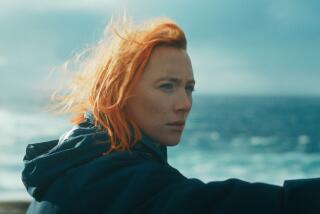For director, it’s personal
- Share via
Throughout her childhood, Australian filmmaker Elissa Down was constantly running after her youngest brother, Sean, who is autistic, suffers from attention deficit hyperactivity disorder and is a selective mute.
“He would run down the street in his underpants, and I’d pull him out of toilets in people’s homes,” says Down. “He played in his pooh. He chewed tampons. And of course, I got frustrated, I got angry. I wished he was normal. I wished I had a different family.”
Sean, who is now 26, was the inspiration for her first feature film, “The Black Balloon,” which opens Friday.
The heartwarming drama, which won best feature film at the Berlin International Film Festival, in the Generation 14plus section, revolves around Thomas (Rhys Wakefield), a 16-year-old who has moved all around Australia because his father is in the army.
The family has just relocated into a new home in suburban Sydney. And it doesn’t take long for his oldest brother, Charlie (Luke Ford), who is autistic, has ADHD and is mute, to cause him embarrassment and draw catty remarks from the neighbors who don’t understand autism.
Toni Collette plays their mother, who is dealing with a difficult pregnancy, and model Gemma Ward plays Thomas’ beautiful girlfriend, who wants to befriend Charlie.
In real life, Down has three younger brothers, the eldest of whom also is autistic. But she doesn’t like to talk much about him or reveal his name, because “he doesn’t like to know that people talk about his autism,” she says. “He’s very intelligent. He is like the ‘Rain Man’ character.”
Brother Sean, she says, was initially diagnosed with ADHD as a child. “It’s when they put him on Ritalin they discovered he was autistic, because all of his behaviors slowed down,” Down says. “They noticed there was a repetitive nature to it.”
Though the movie is semiautobiographical, Down didn’t want “Black Balloon” to be a memoir of her life. “It would seem a bit movie of the week,” she explains. “We wanted to rework the story and the plot and the characters to fit into a movie structure and to make it entertaining for an audience.”
The majority of the response to the film has been overwhelmingly positive, Down says: “Most people love it and laugh and cry.” So she was shocked to learn that some moviegoers have walked out angry.
“It’s because some of them realize they were the kid who threw the chocolate milk at the autistic bus or the neighbor [who made rude comments]. Or they say, ‘If I was the father, I would have walked out on the family.’ I didn’t realize the film would make people feel guilty, even though it’s an uplifting story about love and acceptance and family.”
Down says it wasn’t difficult to watch a version of her life unfold during the filming.
“I see this as a film now, because all of that emotional stuff came out in the writing -- to tell a story honestly from the heart,” she says. “But by the time I got to the directing stage, it was a film and characters.”
Save for Ford. “I would find myself calling him Sean,” she admits. “Luke was so eerily like my brother. My grandma saw a picture of Luke in the paper and thought it was Sean!”
All three of Down’s brothers still live at home, with the middle one helping her parents take care of Sean and the older sibling.
“What I am seeing with my brothers is they are getting more into their autistic shell,” she says. “The older one doesn’t leave the house. Sean will still go out and do stuff. But I think they miss the social interaction they used to get in school.”
--
More to Read
Only good movies
Get the Indie Focus newsletter, Mark Olsen's weekly guide to the world of cinema.
You may occasionally receive promotional content from the Los Angeles Times.











